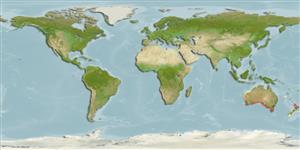>
Blenniiformes (Blennies) >
Blenniidae (Combtooth blennies) > Salariinae
Etymology: Parablennius: Greek, para = the side of + Greek, blennios = mucus (Ref. 45335).
More on author: Richardson.
Issue
Junior synonym Parablennius maoricus (Kner, 1864), is considered valid in Patzner et al., 2009:458.
Environment: milieu / climate zone / depth range / distribution range
Ökologie
seewasser; brackwasser benthopelagisch. Temperate
Eastern Indian Ocean (Australia) to Southwest Pacific (New Zealand).
Size / Gewicht / Alter
Maturity: Lm ? range ? - ? cm
Max length : 13.0 cm TL Männchen/unbestimmt; (Ref. 9002)
Kurzbeschreibung
Bestimmungsschlüssel | Morphologie | Morphometrie
Rückenflossenstacheln (insgesamt) : 12; Rückenflossenweichstrahlen (insgesamt) : 16 - 19; Afterflossenstacheln: 2; Afterflossenweichstrahlen: 19 - 20. Dorsal fin with slight notch over posterior spines; caudal and pectoral fins rounded. Pale to ash-grey in color; young with moderate-sized dark blotches along sides; adults finely spotted (Ref. 9002).
Facultative air-breathing in the genus (Ref. 126274); Adults are found in rock pools and shallow estuaries, commonly under jetties along tops of pylons (Ref. 9002). Oviparous. Eggs are demersal and adhesive (Ref. 205), and are attached to the substrate via a filamentous, adhesive pad or pedestal (Ref. 94114). Larvae are planktonic, often found in shallow, coastal waters (Ref. 94114).
Life cycle and mating behavior
Geschlechtsreife | Fortpflanzung | Ablaichen | Eier | Fecundity | Larven
Oviparous, distinct pairing (Ref. 205).
Kuiter, R.H., 1993. Coastal fishes of south-eastern Australia. University of Hawaii Press. Honolulu, Hawaii. 437 p. (Ref. 9002)
IUCN Rote Liste Status (Ref. 130435: Version 2024-1)
Bedrohung für Menschen
Harmless
Nutzung durch Menschen
Tools
Zusatzinformationen
Download XML
Internet Quellen
Estimates based on models
Preferred temperature (Ref.
123201): 14.2 - 22.8, mean 17.8 °C (based on 394 cells).
Phylogenetic diversity index (Ref.
82804): PD
50 = 0.5000 [Uniqueness, from 0.5 = low to 2.0 = high].
Bayesian length-weight: a=0.00776 (0.00356 - 0.01695), b=3.00 (2.81 - 3.19), in cm total length, based on LWR estimates for this (Sub)family-body shape (Ref.
93245).
Trophic level (Ref.
69278): 2.8 ±0.1 se; based on size and trophs of closest relatives
Widerstandsfähigkeit (Ref.
120179): hoch, Verdopplung der Population dauert weniger als 15 Monate. (Preliminary K or Fecundity.).
Fishing Vulnerability (Ref.
59153): Low vulnerability (10 of 100).
Nutrients (Ref.
124155): Calcium = 78.9 [37.3, 158.6] mg/100g; Iron = 0.36 [0.21, 0.69] mg/100g; Protein = 17.5 [16.4, 18.5] %; Omega3 = 0.392 [0.166, 0.866] g/100g; Selenium = 7.97 [3.19, 19.57] μg/100g; VitaminA = 32.7 [9.2, 109.1] μg/100g; Zinc = 1.22 [0.81, 1.82] mg/100g (wet weight);
